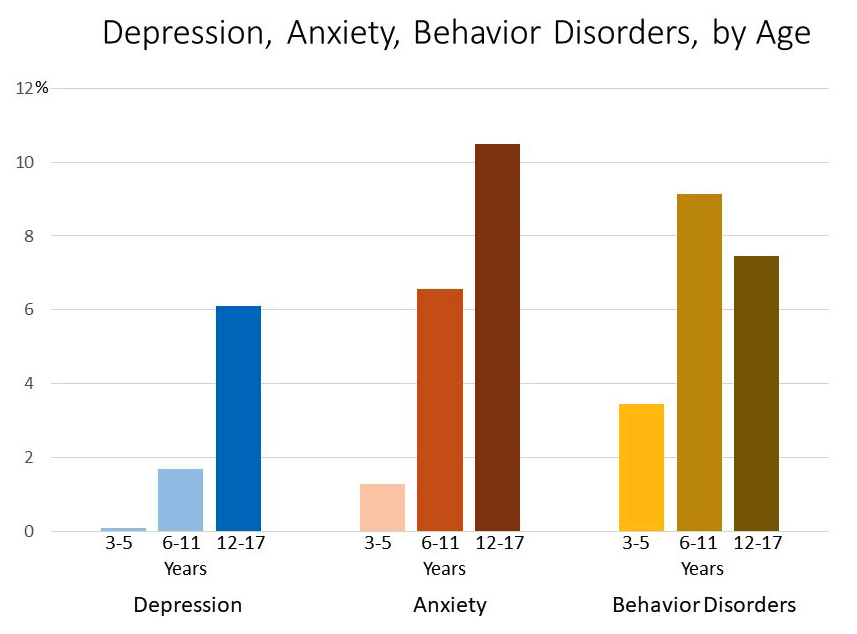
The Triggers of Anxiety and How to Avoid Them
Desiree RasShare
Anxiety is one of the most commonly experienced disorders amongst children and adults in the United States. Studies estimate that around one in eight could have an anxiety disorder. Children may not always exhibit anxiety symptoms quite the same way as adults, but this doesn't mean they don't suffer from many of the same emotional stresses. To express their anxiety, children could display general concern, anger, worry, irritability, and trouble focusing.
Understandably, children do have a common set of age-appropriate childhood worries, such as:
- Stranger anxiety from 7 – 9 months, usually self-resolved by age 3
- Fear of the dark, monsters, insects, and certain animals in preschoolers
- Fear of heights or storms in younger school-age children
- Worry about school, friends, and sometimes what the future holds in adolescents
These worries are daily and part of growing up; they usually resolve or decrease as the child grows older.
What are some common symptoms in children with anxiety?

As much as occasional anxiety is common amongst children, it is unfortunately not uncommon for anxiety to become much more than a simple worry. The estimates vary, of course, but a study done by the CDC found that 9.4% of children between the ages of 3 and 17 have diagnosable anxiety. Suppose you are suspicious that your child’s anxiety might be more than the occasional worry - in that case, these symptoms might help you assess if your child needs clinical diagnosis and treatment.
It is important to note, we are not licensed medical professionals and you should always seek the guidance of your doctor or other qualified health professional with any questions you may have regarding your our your children's health or a medical condition.
Look out for these signs of anxiety:
- Anger or aggressive behavior
- Avoiding certain situations
- Fatigue
- Changes in appetite
- Irritability
- Nervous habits such as nail-biting
- Social withdrawal
- Refusing to go to school
However, symptoms vary from child to child or the nature of the anxiety they experience. As this list is not complete, some triggers of anxiety or fears (such as social anxiety or various phobias) can be experienced in multiple situations. It is also important to note that childhood fears that persist passed the age that they are presumed to fade, for example, fear of the dark or parental separation, are also a point of concern.
Types of Childhood Anxiety Disorders
While there are many types of anxiety disorders, the following are the most commonly experienced by children:
Generalized Anxiety Disorder – Characterized by fatigue, irritability, muscle tension, difficulty concentrating, or sleep disturbances and usually brought upon by worries about school performance, friendships, family relationships, or other activities or concerns.
Separation Anxiety Disorder – Separation Anxiety is developmentally appropriate in children between the ages of 1 and 3. However, for older children, should they have an excessive fear or anxiety about being separated from their parents within reason, it could constitute a diagnosis of Separation Anxiety, commonly characterized by refusal to leave the parent’s side, nightmares about losing the parent, headaches, or nausea.
Selective Mutism – Children who have selective mutism refuse to speak during a specific situation or about a particular object. Should this fear or anxiousness continue for a long time or is out of proportion to the actual danger posed, this fear can be referred to as a phobia. Characteristics include avoiding eye contact and social withdrawal; it is also most diagnosed in children around the age of five.
Specific Phobia – Some children might be scared or show fear/anxiety when around one particular object or if they are present in a specific situation. Should this fear last for an increased amount of time or is out of proportion to the actual danger posed by the object or situation, this fear could be classified as a phobia. Children who exhibit these fears may cry, freeze up, or cling to an adult when their fear is present. Phobias children can have include animals, storms, needles, loud sounds, or enclosed spaces.
Panic Disorder – Children who experience frequent panic attacks or worry about having a panic attack or experiencing more panic attacks could be susceptible to a panic disorder. Children diagnosed with panic disorder might speak of symptoms such as shortness of breath, chest pains, the sensation of choking, nausea, dizziness, fear of “going crazy,” or the fear of dying.
Social Anxiety Disorder – When a child has an intense fear of having to participate in class activities or actions with peers, they could have a social anxiety disorder. Children may exhibit these fears through throwing tantrums, crying, clinging to adults, freezing up, or refusing to speak. Children may also avoid social situations that provoke this fear.
How to help a child with an anxiety disorder?
When a child is diagnosed with an anxiety disorder, it might be uncharted territory for some parents or caregivers. Questions like “how can I help” might cloud their minds, but there are a few things you can do that will help them calm down or start to feel at ease.
The first important thing is to speak to the child about their anxiety and worries. Reassurance and understanding are crucial to giving them the support they need. Letting them know you understand their feelings is a great first step to helping them! If the child is old enough, it could also help by explaining anxiety and its physical effects on the human body.
Secondly, while talking to a child about their anxieties, it is essential to help them find solutions. For example, if a child is anxious about a sleepover, it is only natural to say, “well, then don’t go.” This isn’t a good response as it could seem that the child feels their anxiety keeps them from doing things. Instead, suggest solutions that can help them enjoy the sleepover with a plan in place.
The goal is to be supportive rather than accommodating; in other words, allowing your child to stay home when they don’t want to go to a sleepover means you’re enabling the avoidance. Instead, help the child take small steps toward facing the fear, such as giving them an outlet for anxious energy, for example, using a fidget cube in social settings or squishy pens in a school setting.
It is also vital for an adult who also lives with anxiety to be wary of anxious talk; for instance, at a family gathering, voice your concerns about school security to a family member where a child can overhear it. Children observe their parents’ fears, worries, and anxious talk and could internalize the same thinking and use their parents’ fears to strengthen their anxieties. Being mindful of nervous talk is another way parents can help their anxious kids.
Another area an adult with anxiety should be mindful of is ‘avoidance behavior.’ This is a typical response to previous anxious memories, such as avoiding a particular street after a car accident. Adults who experience this might also repeatedly discuss the origin of the fear. Taking the example of the car accident, if you do avoid a street, you were in an accident, you might also retell the story of how the car cut you off as a new driver. Children who listen to these stories pick these avoidance behaviors up and can see things as this street is dangerous and should be avoided at all costs. To prevent these minor mishaps, ask another adult in your child’s life to be sure that your children have a healthy exposure to your triggers.
Anxiety is relevant in every household and can affect everything from daily routines to school and physical health. Learning the difference between common age-appropriate anxieties and when concern should be raised comes in handy to prevent misdiagnosis or addressing these issues early. It’s also beneficial to identify your own triggers and use coping skills that work for you, not to only help you manage your anxiety but teaches the children around you that they can also learn to cope with their own anxieties and the triggers thereof.
